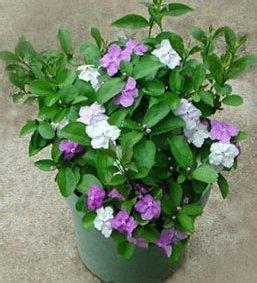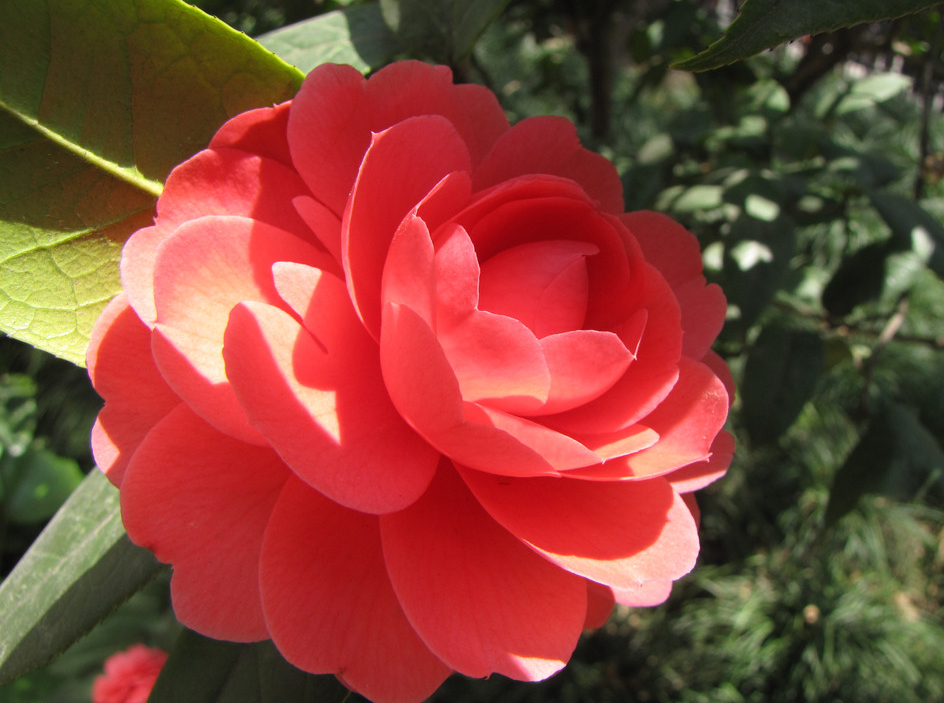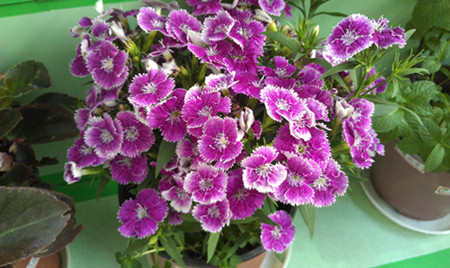How to cultivate bicolor jasmine
Two-color jasmine is named mandarin duck jasmine, five-color jasmine, pan Mo jasmine is Solanaceae, mandarin duck jasmine genus, evergreen shrub, plant height 30cm 100cm. Its origin is in tropical America, and the flowers are dark blue from bud breaking to the beginning of blooming, but two or three days later, under the influence of light, temperature and other factors, the original dark purple pigment of the Corolla gradually disappears and finally becomes pure white. Because the flowers on the same-plant do not bloom successively, the first ones have turned white, and the latter ones are still dark purple. The two-color flowers are placed on the branches like mandarin ducks, and give off a strong jasmine-like fragrance, so it is called "mandarin duck jasmine".

Culture method of two-color jasmine
Two-color jasmine prefers a sunny, warm and humid climate, requires slightly acidic soil with good drainage, and the suitable growth temperature is between 20 and 30 degrees Celsius. Enter the dormant state at 12 degrees Celsius, and the room temperature in winter should not be lower than 13 degrees Celsius. Pot planting in greenhouse in East and North China requires slightly acidic soil with good drainage, and the suitable temperature for growth is 1830 degrees Celsius. Indoor cultivation should have at least 4 hours of light and blossom and flourish under sufficient sunshine. Enter dormancy at 12 degrees Celsius.
The main points of two-color jasmine culture are as follows:
① mandarin duck jasmine likes warm, humid climate and is not resistant to cold. Acid loam with sufficient sunshine and good drainage is required. You need to spend the winter indoors in winter and move outside in spring.
The ② culture soil can be prepared with garden soil: rotten leaf soil: Rice bran ash (1.5%) and barnyard manure. Prune properly when turning the basin in spring, trimming off old roots, withered branches, dense branches and long branches. It needs to be cultivated under a big tree in summer.
③ can gradually increase the amount of water after spring, and can be watered once every two days in summer. Properly spray water on the leaf surface and the surrounding environment to reduce the number of watering in autumn. Winter-watering once every 10 days, too much watering, indoor too wet will lead to fallen leaves or root rot.
④ applied pancake fertilizer and water every 10 to 15 days in spring and summer, and stopped fertilization in autumn to prevent new shoots from freezing.
⑤ reproduction. a. Cutting propagation can be in April to August, cut-annual branches, 8-10 cm long, and can take root 1 month after cutting. The survival rate of full light spray method is high in summer. b. It can also be propagated by striping method, the branches are cut at 15 cm and buried in the soil, they can take root after 3 weeks, and seedlings can be transplanted in vitro in 50 days.
How to prune two-color jasmine and how to breed it
Two-color jasmine this plant is real, itself is a kind of horse tooth plant, can be regarded as a relatively special species. Two-color jasmine is described most of the time is more delicate, two-color jasmine plants are also very rare, leaves will also change color. Today, I would like to introduce to you the cultivation of two-color jasmine and see how to prune it.
How to trim two-color jasmine
First, how to trim two-color jasmine-- blossom
Many people literally think that bicolor jasmine will not blossom, only branches and leaves. But in fact, two-color jasmine will blossom, if you can buy when you can buy already flowering is even better. The flowers of bicolor jasmine are small red flowers, which are particularly beautiful in the green leaves. If you have not seen the flowers of bicolor jasmine, it can only mean that they have not been planted.
2. How to prune and reproduce bicolor jasmine
Bicolor jasmine is a plant that can be cutted. choose to use sturdy branches for cutting treatment, cut off all leaves except the top leaves, and plant them in the soil when dry. The soil prepared with rotten leaf soil and coarse sand can have good water permeability and will not accumulate water and is suitable for two-color jasmine.
Third, how to prune and fertilize two-color jasmine
Two-color jasmine should not be treated with fertilizer in the first two months after planting, but it is also possible to apply fertilizer after the root system of two-color jasmine is fully grown. Two-color jasmine can be fertilized every ten days or so at a suitable fertilization stage. Two-color jasmine has strong vitality and is suitable for beginners to grow.
How to prune two-color jasmine Culture methods and matters needing attention of two-color jasmine
Two-color jasmine, also known as mandarin duck jasmine, five-color jasmine, pan jasmine. Do you know anything about it? Today we are going to tell you how to trim two-color jasmine and how to cultivate two-color jasmine.
Culture methods of two-color jasmine:
Soil: two-color jasmine is generally cultivated in East China and North China, and likes the slightly acidic soil with good drainage and air permeability.
Temperature: the most suitable growth temperature of two-color jasmine is between 20 and 30 ℃. It enters the dormant period under the condition of 12 ℃ and is not resistant to cold. Pay attention to adjust the room temperature in winter.
Lighting: two-color jasmine likes a sunny, warm and humid climate, afraid of hot sun exposure, pay attention to shading in summer, and shine at least four hours a day, so as to ensure the quantity and quality of flowering.
Watering: two-color jasmine like wet, but afraid of waterlogging, watering principle "see dry see wet". In summer, we should not only fully water, but also keep the air moist, spray the leaves with clean water 2 or 3 times a day, and keep the basin soil dry in winter to prevent frostbite.
Fertilization: after the two-color jasmine flower fade, the thin cake fertilizer was applied once, and the liquid fertilizer mainly composed of phosphorus and potassium was applied once after 10 days, and 0.2% potassium dihydrogen phosphate was sprayed on the leaf surface combined with watering to promote flower bud differentiation. In addition, it is necessary to apply secondary thin alum fertilizer and water during the growing period to prevent soil alkalinization and leaf yellowing.
Pest control: in the red spider damage period, 40% omethoate 1000-1500 times liquid spray can be used to control.
Pruning: cut off the residual flowers after the flower fade, cut off some long branches, cut off the weak branches, introverted branches, disease and insect branches at the end of autumn, to ensure the growth of two-color jasmine in the coming year.
Points for attention in two-color jasmine culture:
1. Two-color jasmine likes warm, humid climate and is not resistant to cold. Acid loam with sufficient sunshine and good drainage is required. You need to spend the winter indoors in winter and move outside in spring.
2. The cultivation soil can be used garden soil: rotten leaf soil: Rice chaff ash (1.5 / 1 / 1 / 0.5), properly mixed with barnyard manure. Prune properly when turning the basin in spring, trimming off old roots, withered branches, dense branches and long branches. It needs to be cultivated under a big tree in summer.
3. The amount of water can be gradually increased after spring, and can be watered once every 2 days in summer. Properly spray water on the leaf surface and the surrounding environment to reduce the number of watering in autumn. In winter, it is usually watered once every 10 days, and too much watering will lead to fallen leaves or root rot.
4. Apply pancake fertilizer and water (20%) every 10 to 15 days in spring and summer, and stop fertilization in autumn to prevent new shoots from freezing damage.
How to trim bicolor jasmine
The specific pruning methods vary from plant to plant, but generally speaking, the pruning principle is to reduce the plant height, make it produce more new branches, blossom more, and renew the old branches. generally speaking, it is to truncate the flowering branches after flowering, cut off the residual flowers after each flower fade, and cut off some long branches to make them sprout more branches, make the tree compact and beautiful, so as to blossom more next month, and after the last blossom at the end of autumn. Heavy pruning, that is, leaving 2-3 buds per branch, cutting off the rest, and cutting off the thin branches, introverted branches, disease and insect branches, in order to grow vigorously in spring next year, and the branch crown two-color jasmine blossoms.
- Prev

Culture skills and methods of Tea Plum
If the potted soil is potted tea plum, the suitable soil is loose texture, smooth drainage, fertile and slightly acidic soil. In the north, it is appropriate to use rotten leaf soil or peat soil as the main culture soil. The clay pot is the best for tea plum planting, to facilitate air permeability and water absorption, and the new basin is soaked in water-available after day and night annealing.
- Next

How to raise Carnation Flower
The carnation is one of the traditional famous flowers in China. Many flower friends want to raise it, but they often have the heart to raise it, but they can't raise it well. So how to raise the carnation flower? this article tells you how to raise the carnation flower from the most basic starting point. Let's take a look at the breeding method of the carnation flower.
Related
- Fuxing push coffee new agricultural production and marketing class: lack of small-scale processing plants
- Jujube rice field leisure farm deep ploughing Yilan for five years to create a space for organic food and play
- Nongyu Farm-A trial of organic papaya for brave women with advanced technology
- Four points for attention in the prevention and control of diseases and insect pests of edible fungi
- How to add nutrient solution to Edible Fungi
- Is there any good way to control edible fungus mites?
- Open Inoculation Technology of Edible Fungi
- Is there any clever way to use fertilizer for edible fungus in winter?
- What agents are used to kill the pathogens of edible fungi in the mushroom shed?
- Rapid drying of Edible Fungi

